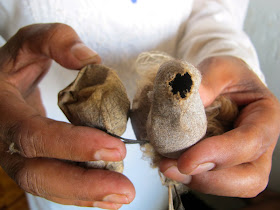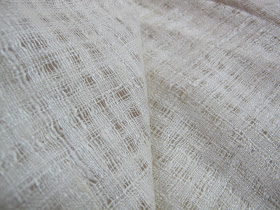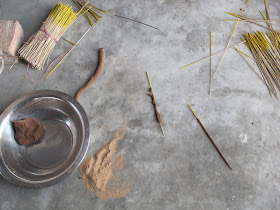▼
SCRAP & FLUFF...piles of possibility
what if this turned into this...
....and it does.
Our fabric necklaces handmade in Cambodia by a fair trade organization supports the livelihood of vulnerable artisans who create from various remnant waste in fabric and metals(bullets & bombshell casings - yes you heard me correctly).
AHIMSA......& silk
AHIMSA is a sanskrit term generally meaning to do no harm; literally the avoidance of violence.
AHIMSA means kindness and non-violence towards all living things including animals; it respects living beings as a unity, the belief that all living things are connected. Hence AHIMSA is a binding code of conduct which implies a ban on hunting, butchery, meat eating, and the use of animal products provided by violent means.
AHIMSA is an important tenet of Indian religions: Hinduism, Jainism and Buddhism. Hindus do not substantially differentiate the soul within a human body from that of an animal. The question of moral duties towards animals and of negative karma incurred from violence against them, is discussed in detail in some Hindu scriptures and religious law books. There are some Jains(a religious group with many similarities to Buddhists) who take this philosophy so deeply to heart that they avoid killing even the smallest creatures, and provide special houses where insects swept up in household dirt can live out their lives. The expression of this philosophy, particularly in Western culture, is not usually so extreme - but it gives a good example of strict interpretations of the AHIMSA path.
The historic Indian leader Mahatma Gandhi strongly believed in AHIMSA as a way of life. Avoidance of verbal and physical violence is also a part of this principle, although AHIMSA recognizes self-defense when necessary, as a sign of a strong spirit. It is closely connected with the notion that all kinds of violence entail negative karmic consequences in this cause and effect world.(more about Karma later)
AHIMSA Silk, also known as Peace Silk, is processed from cocoons without the otherwise compulsory killing of the pupae inside. In the vast majority of cases, it's more complicated than it appears. There are two main types of AHIMSA Silk, cultivated and "wild" (semi-domesticated).
Most cultivated AHIMSA Silk is from the moth Bombyx mori. It is raised just like conventional cultivated silk, right up to the point where the cocoons would be stifled, or processed with heat, in order to kill the pupae and keep it from breaking through the cocoon, yet AHIMSA cocoons are all allowed to hatch and breed, and the silk is processed from these hatched cocoons. In some cases, the cocoons can be cut open and the pupae tipped out; this avoids the moth soiling the cocoon with its urine.
In this process each fertilized female moth will lay between 200 and 1000 eggs, averaging around 400. In India, where the vast majority of AHIMSA silk is being raised, most silkworm strains are multivoltine. This means that the silkworms do not undergo any refrigeration, and the eggs will hatch approximately two weeks after being laid. The ones that are not fed may die within a day of hatching, from a combination of dessication and starvation. In a batch of, say, 20,000 cocoons, this means that the next generation (if they were all raised) would be two and a half million, and the generation after that, three hundred twelve million. Do the math - It's just not possible to feed so many.
While it may be true that the individual caterpillar that spun the cocoon didn't die inside it, its offspring may be ruthlessly culled. Is it considered more virtuous to create conditions of wholesale starvation then to avoid killing the pupea quickly with heat? Any large scale farming of silk worms will create the causes and conditions for such. Anyone sensitive enough to consider AHIMSA silk as an option should carefully consider all processes & research the source of their silk. This world requires responsible consumerism, there is no turning back.
The different types of silk worms and their diet:
Bombyx mori (Mulberry silkworm) feeds on Mulberry leaves, Philosomia ricini (Eri silkworm) on Castor leaves, Anthraea assama (Muga silkworm) on Som and Soalu leaves, Anthraea proylei (Temperate/ Oak Tasar silkworm) on Oak leaves and Anthraea mylitta (Tropical Tasar silkworm) on Terminalia leaves.
a breeding AHIMSA cocoon
The first signs that a cocoon is about to hatch, is that it will become wet on one end, and often rock back and forth. The wet spot is from an enzyme called cocoonase which the moth squirts out of its head to partially dissolve the cocoon threads. Cocoons usually hatch at dawn, and usually about two weeks after the start of spinning.
The final product of AHIMSA silk thread made, by boiling down the remnant cocoon and so thus the threads separate from the organic plaster that holds the cocoon's shape. From these threads spinning and then weaving may happen.
AHIMSA silk samples
varietal weave from Jharkand
from Assam
I heart elephants
Did you know "the Heart of an elephant weighs between 20-30 kg (40 and 60 pounds) and beats about 30 times a minute?
Indian elephants are largest weighing 8,000 and 9,000 pounds. In general, the smallest animals have the highest heart rates. The canary has been reported to have a rate of 1,000 beats, and the large domestic animals show rates of 40 or 50 beats. The elephant, with a rate of about 30 beats, fits perfectly into the picture, being the largest animal and having the lowest heart rate of any of the animals thus far studied.
from The Heart Rate of the Elephant by Francis G. Benedict, Robert C. Lee
I just can't resist these adorable applique/embroidered elephants of Rajasthan. I have been to India umpteen times but somehow, every time I manage to find some treasure trove with which I become completely obsessed. So the 2011 search for the new procured these animate elephant handworked pillowcovers which have probably been around forever, they are hanging all over the lanes of the main bazaar PaharGanj, but just recently some variations in stonewashed fabrics & florescent threadworks have caught my eye in one Rajasthali shop in Delhi.
Stay tuned in the near future for an AtelierOM bespoke collection of Elephants and other appliqued beasts on various khadi and natural linens done in collaboration with Rajasthani Female Artisans of SURE - Society to Uplift Rural Economy....maybe even a limited edition cloth children's book is in development to benefit human and beasts alike!)
The Handicraft programme of SURE was initiated with 224 women Artisans. Today SURE is successfully running 15 production centers supporting over 600 Artisans. Women are involved intimately from the production of handicrafts to the marketing of them. The main aim of the handicraft programme is to maximize the profits of the women workers and encourage them to become dignified entrepreneurs over being just casual wage-workers. the new black
..............is MALKHA Black, a handspun handloomed cotton naturally dyed with iron to become a 21st century black. Atelier OM is developing a line to include black apparel that won't harm you, your planet or your wallet. Get ready to make the right choice for your wardrobe.
In the last few hundred years the weaving of cotton cloth in India on the handloom has had its ups and downs but has never died out. It has been weakened but not killed by mass-production on powerlooms. It is only when one wears powerloom fabrics that one notices the poor draping quality and harder feel. Dyes on powerloom cotton fabric also fade much quicker than on handloom.
Malkha - also called the freedom fabric - is pure cotton cloth which is woven using traditional methods as well as modern technology. The cloth, because it isn't heavily processed, retains its inherent texture, breathability, and springiness. It drapes well, and looks beautiful whether natural, colored, or printed. In short, it's cotton with character.
Cotton now is largely mass produced in spinning mills situated far away from where the cotton is actually grown. Once farmers have sold the cotton, they're cut out of the equation. Further, weavers working in these mills are no longer craftsmen with individuality. For a daily wage, their job is to weave as much homogenized, neutralized cotton cloth as possible.
Uzramma - the woman behind Malkha - is working to empower farmers and weavers by ensuring that production, dyeing, and weaving all take place in the same unit. Not only does this allow all those involved to be closer to the finished product, it also avoids environmentally harmful steps such as transportation, and the baling and unbaling of cotton - a process which uses heavy industrial machinery. In an interview with Mint, Uzramma said that what Malkha is doing is not "revivalism", rather, it is using the "strength of the Indian textile production traditions in a contemporary context."
everything fit to print
At the Studio of next Gen of blockprinters in BHUJ, Gujarat:
In the "Khatri" muslim community, the art of blockprinting among other crafts passes from father to son.
Zubair discusses a pending order while workers look on.
Years of inks, color a wall behind a printing table
the process of printing and coloring
son & father

bespoke samples of eri silk stoles in natural colors that AtelierOM is creating.
Other natural dye prints on our khadi ahimsa silks below
IKAT SAREES of ODISHA
Sambalpuri Saree is a traditional handwoven IKAT saree. For those unfamiliar, a saree is simply an unstitched cloth, ranging in length from four to nine metres of silk or cotton which is then draped and pleated skillfully, elegantly over the body in various styles, depending on region and occasion - to create one of the most fashionable looks ever for a woman!(see my other post about saree styles)
The most skilled IKAT weavings are produced in Bargarh, Sonepur, Sambalpur and nearby districts of Odisha. Most of them have been named after the places of their origin, and are popularly known as PATA.
It is believed that this art migrated to Western Orissa along with the Bhulia community who fled Northern India in the year 1192AD after the fall of Chouhan empire at the hands of the Mughals. Since then up to the year 1925 the traditional craft flourished in Western Odisha in a limited number of designs & natural vegetable colorings which represented the identity of different village women. Unfortunately now those natural dyes are an uncommon part of the process, though still in existence for high end cosmopolitan clientele and the cotton versions are still worn by local tribal women who maintain the consistency of this dress. These sarees were originally known as 'Bhulia-Kapta'.
What distinguishes this woven textile of IKAT from others is that both the warp and the weft in the fabrication are tie-dyed before weaving.(warp images below)
The traditional craftsmanship of the 'Bandhakala', the Tie-Dye Art, is integral to the intricate weaves of IKAT. In this meticulous technique, small bundles of the silk/cotton threads are tied/wrapped by hand(called 'Baandha') while fixed on a large horizontal portable frame according to the desired end patterns. The weavers most often work from home setting up on the very porches of their traditional mudhouses. Young boys are often employed to do the "bandha" work as the required skills and the design logic applied must be taught from 10 years on to impart the knowledge to become a prolific weaver.
the frame for "Bandha"
This "Bandha" technique ultimately prevents the absorption of dyes into certain areas of the threads which thus creates the IKAT. These same threads go through various color dyes, re-tyings and design processes before being finally fixed on the wooden loom for the hand weaving of the end fabric.
"Bandha" process of tying the yarns before dying
detailed knots of "Bandha"
The unique design feature of this IKAT form is that the motifs and patterns are represented almost identically on both side of the fabric. This versatile technique enables a craftsman to weave the multi colored patterns and images into a fabric which often is done to inspire a thought or convey a story. The entire process sometimes takes a weaver many months thus the costliness of these sarees in silks from $200-$4,000.
a very difficult skill to produce designs in the round and script
such creations can only be done by A MASTER WEAVER-
Sarat Kumar Patra(pictured) and his brother, Sahadev Patra are national awardees for their skill in IKAT.
journals of color, hands full of nature
Natural dyes in India: each region has its own formula for treating cloth, ie. predye, secret additives, mordants and the water - its all about the water and of course the seasons. Every master dyer has done his/her due diligence and has kept some record of their rainbow alchemy. Meet one such man who has worked for 25 years with a weaving cluster in Sonepur District, Orissa: His knowledge is extensive and unfortunately underused as the chemical dyes outweigh natural colorings these days in the making of Pata sarees where the warp and weft are dyed before weaving.(next post)
master dyer: Sakanta
local dye ingredients Orissa




















































